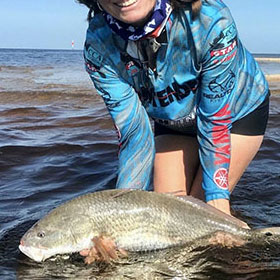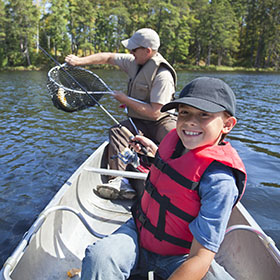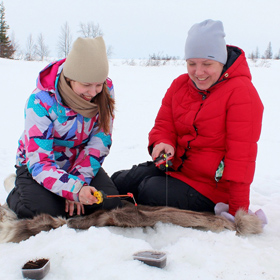Winterizing a Boat Checklist: 10 Things to Do Before Seasonal Storage
By Debbie Hanson
Dec 27, 2022
Winterizing a boat checklist that summarizes ten general steps to ensure your prized fish catching vessel withstands storage, runs smoothly when spring arrives.
While steps may vary based on the average low temperatures in your state and the type of motors or accessories your boat has, this winterizing a boat checklist will give you a general idea of the steps you need to take prior to seasonal storage. Always consult your engine owner’s manual for a boat winterization checklist that’s specific to your engine make and model.
Winterizing Your Boat Checklist
This checklist for winterizing boats can help ensure that your prized fish-catching vessel is ready to go and running smoothly when spring arrives.
1. Block up Your Boat
The first step in the winterize your boat checklist should be to remove your boat from the water and block it up using cement blocks or boat stands with plywood bases to distribute the weight of the boat evenly. Improper blocking can cause stress cracks or other structural issues over time.
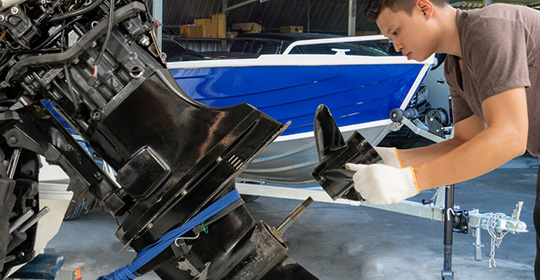
2. Flush the Engine
One of the first items on your boat engine winterization checklist should be to flush and drain any dirt, salt, or other contaminants from your engine. Use a hose to flush the engine if it has a self-contained rinse (most newer boat models have a self-contained rinse or hose hook up) or use an earmuff flusher which slides onto the lower unit of an engine.
3. Fog the Engine
To prevent carburetor rust, the next item on your boat winterizing checklist should be engine fogging. Start engine and spray fogging oil directly into carburetor or intake. Then, pull spark plugs and spray fogging fluid into top of cylinders. The fogging oil will lubricate all the internal parts, such as the cylinder walls and piston rings, and will help to prevent rusting and corrosion. Spray fogging oil until engine stalls, giving it an extra heavy spray just as the engine starts to die. There may be a considerable amount of smoke that comes out of the engine, but this is normal. Leave the engine off at this point and turn off the fresh water source.
4. Drain Water Lines
The next step on your boat winterization checklist is to drain any water from the water separators and change fuel/water separators in the system. Lubricate the linkages and pivot points. Grease or lubricate all throttle, shift cables, steering linkage and starter shaft using a grease gun and lithium grease or lubricant. Pull all drain plugs on the engine to remove all water from the block (this applies if you have an inboard motor). Remove water from all additional systems such as washdowns, live wells, and bilge pump.
5. Use Antifreeze for Inboard Engines
If you have an outboard engine, no antifreeze is required since outboards drain completely when in the down or running position. However, an inboard boat winterizing checklist should include replacing drain plugs and filling the block, manifolds, and water tanks with non-toxic, pink antifreeze. Be sure to completely drain the freshwater tank and hot water heater. Turn the water heater off, then add antifreeze to the water tank and pump it through your hot and cold plumbing (include shower and wash down areas).
6. Check and Replace Fluids
When going through your winterize boat checklist, fill your fuel tank to avoid condensation build up while in storage (leave a little room for expansion), then add the proper amount of fuel stabilizer to the tank by following the instructions on the stabilizer. Drain and refill the gear case, then change the oil and filter. Use the type of marine engine oil that is specified in your owner's manual and fill the oil tank.
7. Wash and Detail Your Boat
Pressure wash the hull of the boat to remove any water stains, debris, dirt, barnacles, and algae. While pressure washing, inspect the boat for any damage. Repair any cracks, scratches, or chips with gelcoat paste. Wax your boat to help protect the paint or gelcoat from changes in temperature and check the engine prop in case there is a need for prop repairs.
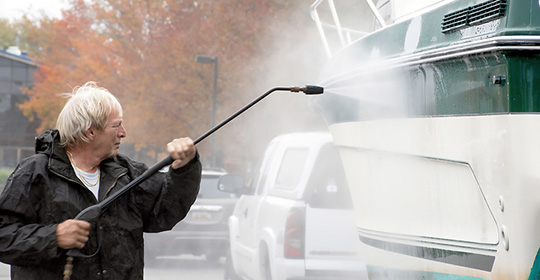
8. Check Sacrificial Anodes
Check the sacrificial anodes (also sometimes referred to as zincs) on your engine’s middle and/or lower unit and replace them if necessary. Anodes help protect your motor from corrosion. Sacrificial anodes provide less protection against corrosion as they dissolve. Be sure change the anodes when they are 50 percent consumed – a good reason why knowing the parts of your boat is important.
9. Remove Accessories and Gear
Remove all electronics, lines, fishing rods, life jackets, fire extinguishers, safety flares, and fenders. Electronics and other accessories can be cleaned and serviced after they are removed from the boat for the winter.
10. Cover Your Boat
The final step in your winterizing boat checklist should be to cover your boat to protect it from the elements with a breathable mildew resistant boat cover or tarp. Secure the cover with tie down straps and store your boat in a climate-controlled area when possible. Your primary boat winterization goal is to keep out water and moisture to the greatest extent possible.
To sum up, remember to always check the owner manual to get specific winterizing instructions for certain boats and engines. For example, a Yamaha jet boat winterizing checklist may be different from a checklist for other types of engines and boats.


